On 14 July 2017, French author Anne Golon (1921-2017) passed away. She and her husband Serge were well known for a wildly popular series of historic novels about an irresistibly beautiful and untamable heroine called Angélique. With more than 150 million copies sold in 45 languages, Angélique is one of the most successful book series of the 20th century. During the 1960s, director Bernard Borderie adapted the novels into a series of five films featuring Michèle Mercier as Angélique.

Vintage card. Photo: publicity still for Angélique, marquise des anges/Angélique (Bernard Borderie, 1964) with Michèle Mercier.
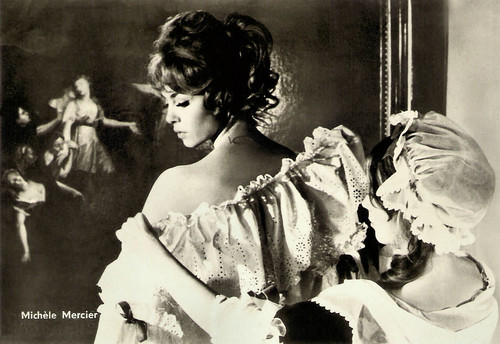
Michèle Mercier. East-German postcard by VEB Progress Film-Vertrieb, Berlin, no. 25/71, 1971. Retail price: 0,20 DM. Photo: Progress.

West-German postcard by ISV, no. H-137. Photo: publicity still for Angelique et le roy/Angélique and the King (Bernard Borderie, 1965).
Anne and Serge Golon published a series of 13 French historical adventure books on Angélique. In fact, Anne Golon is the author and her husband Serge did much of the historical research. International publishers published their books with as the authors name Sergeanne Golon
Anne was born Simone Changeux in Toulon, a port in south-eastern France, in 1921. She was the daughter of Pierre Changeux, a scientist and a captain in the French Navy. She was interested in painting and writing from early childhood and published her first novel, The Country from behind my Eyes, when she was 18 under the pen name Joëlle Danterne.
During World War II Anne travelled via bicycle through France to Spain. She wrote using different pen-names, helped to create France Magazine, and was awarded a literary prize for The Patrol of the Saint Innocents.[4]
She was sent to Africa as a journalist, where she met Vsevolod Sergeïvich Goloubinoff, her future husband, Serge Golon. Their first novel, Angélique, the Marquise of the Angels, was published in 1957. The book was an overnight success. Heroine Angélique de Sancé de Monteloup is a lusciously beautiful 17th Century woman, fifth child of an impoverished country nobleman in the Poitou marshlands in the west of France.
Wikipedia gives a bit ironic summary of the successive books: "she marries at a young age the romantic and talented Count of Toulouse; gets her domestic bliss destroyed when King Louis XIV has her husband executed on trumped up charges; descends into the underworld of Paris; emerges and through a turbulent second marriage gets admittance to the court in Versailles; loses her second husband in war, just as she had started to truly love him, and subsequently refuses to become the King's mistress; finds that her first husband is after all alive and is hiding somewhere in the Mediterranean; sets out on a highly risky search, gets captured by pirates, sold into slavery in Crete, taken into the harem of the King of Morocco, stabs the King when he tries to have sex with her, and stages a daring escape" etc.
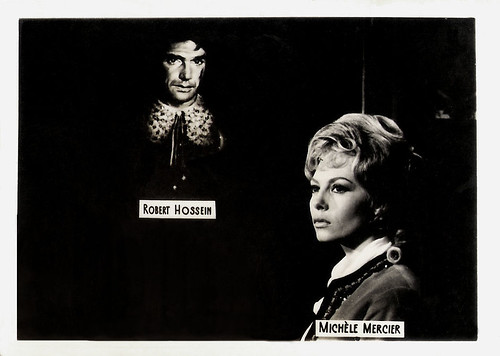
Robert Hossein and Michèle Mercier. Romanian mini-card.
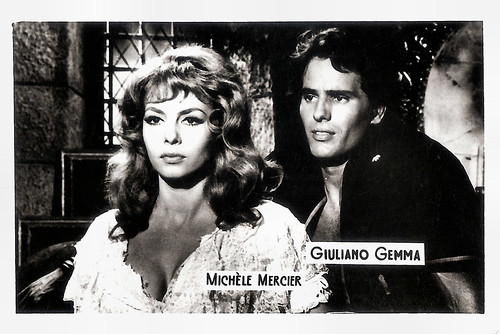
Romanian mini-card. Photo: publicity still for Angélique, marquise des anges/Angélique (Bernard Borderie, 1964) with Michèle Mercier and Giuliano Gemma.
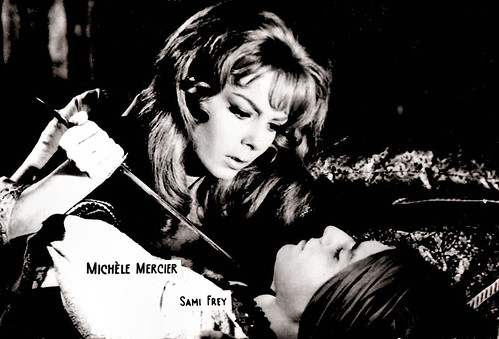
Small Romanian collectors card. Photo: publicity still for Angélique et le roy/Angelique and the King (Bernard Borderie, 1966) with Michèle Mercier and Samy Frey.
Some of the Angélique novels were adapted into a series of five popular films:
According to James Travers at Films de France, Angélique, Marquise des Anges/Angélique is notably the best of the series: "the adventures of a beautiful 17th century marquise, Angélique, played magnificently by Michèle Mercier. Although rarely seen outside of continental Europe, these films were very successful in France in the 1960s and display that country's unique flair for historical costume dramas."
The films were a joint production of France, Italy and Germany. Director of the whole series of films was Bernard Borderie and the main stars were Michèle Mercier as Angélique Sancé de Monteloup and Robert Hossein as Jeoffrey de Peyrac.
Other characters were played by Jean Rochefort as Desgrez, Giuliano Gemma as Angelique's childhood friend Nicolas Merlot, Jacques Toja as King Louis XIV, Claude Giraud as Angélique's second husband Philippe de Plessis-Bellières, Jean-Louis Trintignant as the poet Claude le Petit, Samy Frey as Bachtiary Bey, Estella Blain as the evil Madame De Montespan, Fred Williams as Ràkóczi, and in the final film Jean-Claude Pascal as Sultan Osman Ferradji.
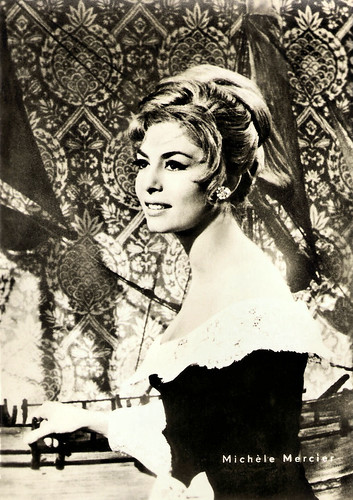
Michèle Mercier. East-German postcard by VEB Progress Film-Vertrieb, Berlin, no. 35/71, 1971. Retail price: 0,20 DM. Photo: Progress.
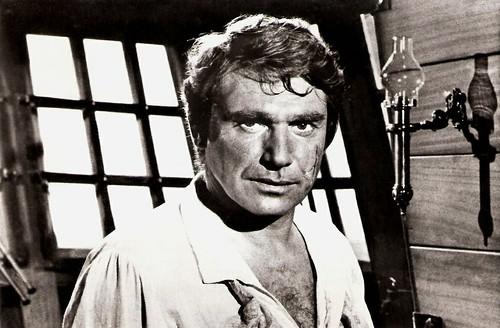
Romanian postcard by Casa Filmului Acin. Photo: publicity still for Indomptable Angelique/Untamable Angelique (Bernard Borderie, 1967) with Robert Hossein and Michèle Mercier.

Romanian postcard by Casa Filmului Acin. Photo: publicity still for Indomptable Angelique/Untamable Angélique (Bernard Borderie, 1967) with Robert Hossein and Michèle Mercier.
The Angélique films were popular all over Europe. They were also very popular in Central Europe where the postcards used for this post were published, by Progress in East-Germany and by Acin in Romania.
During the 1970s, all the kids at my school were exited to see the Angélique films when they were shown on Dutch television. Romance, adventure, and a tiny bit of nudity. We loved it.
To my surprise, two Turkish Angélique films exist as well: Anjelik Osmanli saraylarinda/Angélique in the Ottoman Palaces (Ülkü Erakalin, 1967) and Anjelik ve Deli Ibrahim/Angelique and Deli Ibrahim (Süha Dogan, 1968), both starring Sevda Ferdag as Anjelik 'Angélique de Peyrac'. The first film gets a 7,9 rating at IMDb.
In 2013, a remake of Angélique, marquise des anges went in premiere: Angélique (Ariel Zeitoun, 2013). Nora Arnezeder played Angelique and Gérard Lanvin Joffrey de Peyrac.
At IMDb, the film received a poor rating of only 5,6, but Polish reviewer Malgga liked it 'very, very much': "A beautiful, engaging and immensely romantic rendition of the 'Beauty and the Beast' fairy tale motive".

Romanian postcard by Casa Filmului Acin, no. 277. Photo: publicity still for Angelique et le sultan/Angelique and the Sultan (Bernard Borderie, 1968) with Robert Hossein.
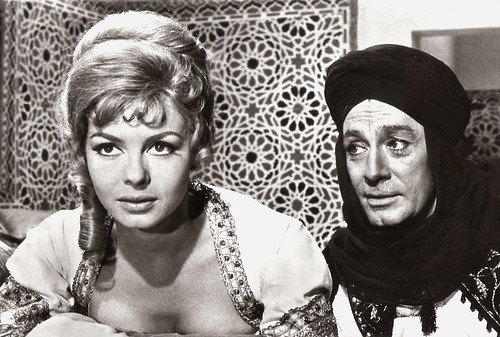
Romanian postcard by Casa Filmului Acin. Photo: publicity still for Angelique et le sultan/Angelique and the sultan (Bernard Borderie, 1968) with Michèle Mercier and Jean-Claude Pascal.

French photo by Francos Film - C.I.C.C. (Paris), Gloria Film (Munich), Fono Roma (Rome). Publicity still for Indomptable Angélique/Untamable Angelique (Bernard Borderie, 1967).
In 1972, Anne and Serge Golon went to Canada to continue their research. That year, as Anne wrote Angélique and the Ghosts, but Serge died. They had four children: Cyrille (born February 1950), Nadine (born July 1955), Pierre (born April 1957), and Marina (born 1961).
Anne carried on writing and brought up her four children at the same time. Between Serge's death and 1985, Anne wrote four more volumes, beginning with the second half of Ghosts (both portions published in French as a single volume, Angélique à Quebec (Angelique in Quebec)) and proceeding through Victoire d'Angélique (Angélique's Victory).
Anne Golon was reduced to a state close to poverty and filed a lawsuit against the French publisher Hachette for abuse of copyright and for her unpaid royalties. She won her battle over the publishing rights to her Angélique stories.
After a legal battle in France lasting nearly a decade, she reached an agreement which left her the sole owner of the works. In 2009, Golon announced two more books would follow: Royaume de France, (Kingdom of France), and a fifteenth and final volume to complete the series.
On 14 July 2017 Anne Golon died in Versailles, Yvelines, France. She was 95. Estimates of the total number of Angélique books sold worldwide are upwards of 150 million, and they have been published in at least 63 countries, by at least 320 different publishers.
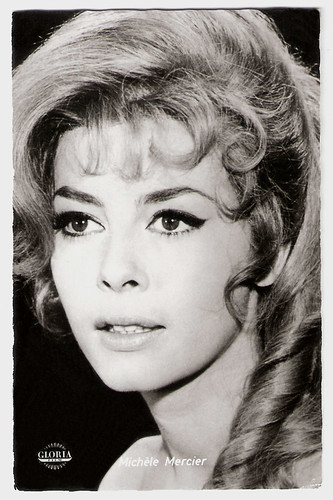
West-German postcard by Friedrich-W. Sander-Verlag / Kolibri-Verlag, Minden-Westf., no. 2420. Photo: Gloria-Film. Publicity still for Angélique, marquise des anges/Angélique (Bernard Borderie, 1964).
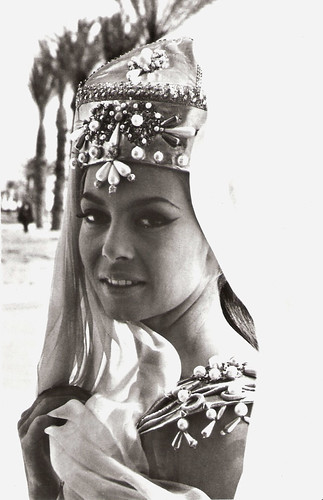
Romanian postcard by Casa Filmului Acin. Photo: publicity still for Angelique et le sultan/Angelique and the sultan (Bernard Borderie, 1968) with Michèle Mercier.
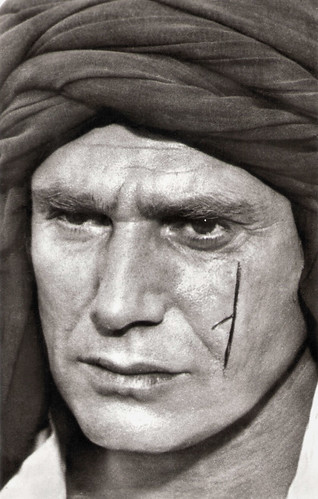
Romanian postcard by Casa Filmului Acin. Photo: publicity still for Angelique et le sultan/Angelique and the Sultan (Bernard Borderie, 1968) with Robert Hossein.
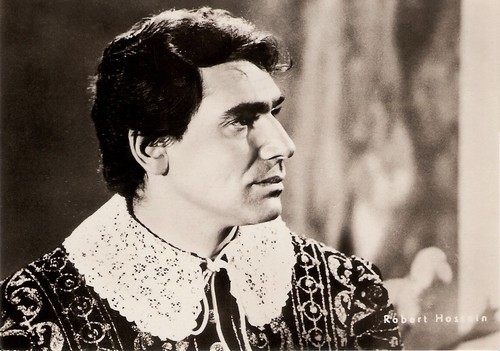
Robert Hossein. East-German postcard by VEB Progress Film-Vertrieb, Berlin, no. 32/71. Retail price: 0,20 M.
Sources: James Travers (Films de France), Wikipedia and IMDb.

Vintage card. Photo: publicity still for Angélique, marquise des anges/Angélique (Bernard Borderie, 1964) with Michèle Mercier.

Michèle Mercier. East-German postcard by VEB Progress Film-Vertrieb, Berlin, no. 25/71, 1971. Retail price: 0,20 DM. Photo: Progress.

West-German postcard by ISV, no. H-137. Photo: publicity still for Angelique et le roy/Angélique and the King (Bernard Borderie, 1965).
An Overnight Success
Anne and Serge Golon published a series of 13 French historical adventure books on Angélique. In fact, Anne Golon is the author and her husband Serge did much of the historical research. International publishers published their books with as the authors name Sergeanne Golon
Anne was born Simone Changeux in Toulon, a port in south-eastern France, in 1921. She was the daughter of Pierre Changeux, a scientist and a captain in the French Navy. She was interested in painting and writing from early childhood and published her first novel, The Country from behind my Eyes, when she was 18 under the pen name Joëlle Danterne.
During World War II Anne travelled via bicycle through France to Spain. She wrote using different pen-names, helped to create France Magazine, and was awarded a literary prize for The Patrol of the Saint Innocents.[4]
She was sent to Africa as a journalist, where she met Vsevolod Sergeïvich Goloubinoff, her future husband, Serge Golon. Their first novel, Angélique, the Marquise of the Angels, was published in 1957. The book was an overnight success. Heroine Angélique de Sancé de Monteloup is a lusciously beautiful 17th Century woman, fifth child of an impoverished country nobleman in the Poitou marshlands in the west of France.
Wikipedia gives a bit ironic summary of the successive books: "she marries at a young age the romantic and talented Count of Toulouse; gets her domestic bliss destroyed when King Louis XIV has her husband executed on trumped up charges; descends into the underworld of Paris; emerges and through a turbulent second marriage gets admittance to the court in Versailles; loses her second husband in war, just as she had started to truly love him, and subsequently refuses to become the King's mistress; finds that her first husband is after all alive and is hiding somewhere in the Mediterranean; sets out on a highly risky search, gets captured by pirates, sold into slavery in Crete, taken into the harem of the King of Morocco, stabs the King when he tries to have sex with her, and stages a daring escape" etc.

Robert Hossein and Michèle Mercier. Romanian mini-card.

Romanian mini-card. Photo: publicity still for Angélique, marquise des anges/Angélique (Bernard Borderie, 1964) with Michèle Mercier and Giuliano Gemma.

Small Romanian collectors card. Photo: publicity still for Angélique et le roy/Angelique and the King (Bernard Borderie, 1966) with Michèle Mercier and Samy Frey.
Unique flair for historical costume dramas
Some of the Angélique novels were adapted into a series of five popular films:
- Angélique, Marquise des Anges/Angélique (1964).
- Merveilleuse Angelique/Angelique: The Road to Versailles (1965).
- Angélique et le roy/Angelique and the King (1966).
- Indomptable Angelique/Untamable Angelique (1967).
- Angélique et le sultan/Angelique and the Sultan (1968).
According to James Travers at Films de France, Angélique, Marquise des Anges/Angélique is notably the best of the series: "the adventures of a beautiful 17th century marquise, Angélique, played magnificently by Michèle Mercier. Although rarely seen outside of continental Europe, these films were very successful in France in the 1960s and display that country's unique flair for historical costume dramas."
The films were a joint production of France, Italy and Germany. Director of the whole series of films was Bernard Borderie and the main stars were Michèle Mercier as Angélique Sancé de Monteloup and Robert Hossein as Jeoffrey de Peyrac.
Other characters were played by Jean Rochefort as Desgrez, Giuliano Gemma as Angelique's childhood friend Nicolas Merlot, Jacques Toja as King Louis XIV, Claude Giraud as Angélique's second husband Philippe de Plessis-Bellières, Jean-Louis Trintignant as the poet Claude le Petit, Samy Frey as Bachtiary Bey, Estella Blain as the evil Madame De Montespan, Fred Williams as Ràkóczi, and in the final film Jean-Claude Pascal as Sultan Osman Ferradji.

Michèle Mercier. East-German postcard by VEB Progress Film-Vertrieb, Berlin, no. 35/71, 1971. Retail price: 0,20 DM. Photo: Progress.

Romanian postcard by Casa Filmului Acin. Photo: publicity still for Indomptable Angelique/Untamable Angelique (Bernard Borderie, 1967) with Robert Hossein and Michèle Mercier.

Romanian postcard by Casa Filmului Acin. Photo: publicity still for Indomptable Angelique/Untamable Angélique (Bernard Borderie, 1967) with Robert Hossein and Michèle Mercier.
A Turkish Angélique
The Angélique films were popular all over Europe. They were also very popular in Central Europe where the postcards used for this post were published, by Progress in East-Germany and by Acin in Romania.
During the 1970s, all the kids at my school were exited to see the Angélique films when they were shown on Dutch television. Romance, adventure, and a tiny bit of nudity. We loved it.
To my surprise, two Turkish Angélique films exist as well: Anjelik Osmanli saraylarinda/Angélique in the Ottoman Palaces (Ülkü Erakalin, 1967) and Anjelik ve Deli Ibrahim/Angelique and Deli Ibrahim (Süha Dogan, 1968), both starring Sevda Ferdag as Anjelik 'Angélique de Peyrac'. The first film gets a 7,9 rating at IMDb.
In 2013, a remake of Angélique, marquise des anges went in premiere: Angélique (Ariel Zeitoun, 2013). Nora Arnezeder played Angelique and Gérard Lanvin Joffrey de Peyrac.
At IMDb, the film received a poor rating of only 5,6, but Polish reviewer Malgga liked it 'very, very much': "A beautiful, engaging and immensely romantic rendition of the 'Beauty and the Beast' fairy tale motive".

Romanian postcard by Casa Filmului Acin, no. 277. Photo: publicity still for Angelique et le sultan/Angelique and the Sultan (Bernard Borderie, 1968) with Robert Hossein.

Romanian postcard by Casa Filmului Acin. Photo: publicity still for Angelique et le sultan/Angelique and the sultan (Bernard Borderie, 1968) with Michèle Mercier and Jean-Claude Pascal.

French photo by Francos Film - C.I.C.C. (Paris), Gloria Film (Munich), Fono Roma (Rome). Publicity still for Indomptable Angélique/Untamable Angelique (Bernard Borderie, 1967).
Reduced to a state close to poverty
In 1972, Anne and Serge Golon went to Canada to continue their research. That year, as Anne wrote Angélique and the Ghosts, but Serge died. They had four children: Cyrille (born February 1950), Nadine (born July 1955), Pierre (born April 1957), and Marina (born 1961).
Anne carried on writing and brought up her four children at the same time. Between Serge's death and 1985, Anne wrote four more volumes, beginning with the second half of Ghosts (both portions published in French as a single volume, Angélique à Quebec (Angelique in Quebec)) and proceeding through Victoire d'Angélique (Angélique's Victory).
Anne Golon was reduced to a state close to poverty and filed a lawsuit against the French publisher Hachette for abuse of copyright and for her unpaid royalties. She won her battle over the publishing rights to her Angélique stories.
After a legal battle in France lasting nearly a decade, she reached an agreement which left her the sole owner of the works. In 2009, Golon announced two more books would follow: Royaume de France, (Kingdom of France), and a fifteenth and final volume to complete the series.
On 14 July 2017 Anne Golon died in Versailles, Yvelines, France. She was 95. Estimates of the total number of Angélique books sold worldwide are upwards of 150 million, and they have been published in at least 63 countries, by at least 320 different publishers.

West-German postcard by Friedrich-W. Sander-Verlag / Kolibri-Verlag, Minden-Westf., no. 2420. Photo: Gloria-Film. Publicity still for Angélique, marquise des anges/Angélique (Bernard Borderie, 1964).

Romanian postcard by Casa Filmului Acin. Photo: publicity still for Angelique et le sultan/Angelique and the sultan (Bernard Borderie, 1968) with Michèle Mercier.

Romanian postcard by Casa Filmului Acin. Photo: publicity still for Angelique et le sultan/Angelique and the Sultan (Bernard Borderie, 1968) with Robert Hossein.

Robert Hossein. East-German postcard by VEB Progress Film-Vertrieb, Berlin, no. 32/71. Retail price: 0,20 M.
Sources: James Travers (Films de France), Wikipedia and IMDb.
1 comment:
it would be lovely if some enterprising publisher were to collect as many cards or photos as is humanly possible and have them all published in something like THE WEEKLY SCRAPBOOK. even unknown, or long-forgotten, stars could be featured, just as long as someone currently famous is on the front cover.
Well, i am waiting!!
when can i see such a magazine on my local newsstand?
start with, say, brad pitt or george clooney to get sales booming, making sure to include alain delon, jean sorel, gina lollobrigida etc. in the same issues. Part one this week, part two next week and so on until there are thousands and thousands of pictures of a particular star.
oh, well, no harm in dreaming. but thank you for reading this far.
KIND REGARDS, DESMOND, SOUTHERN IRELAND, WEDNESDAY, JUNE 3, 2015.
Post a Comment